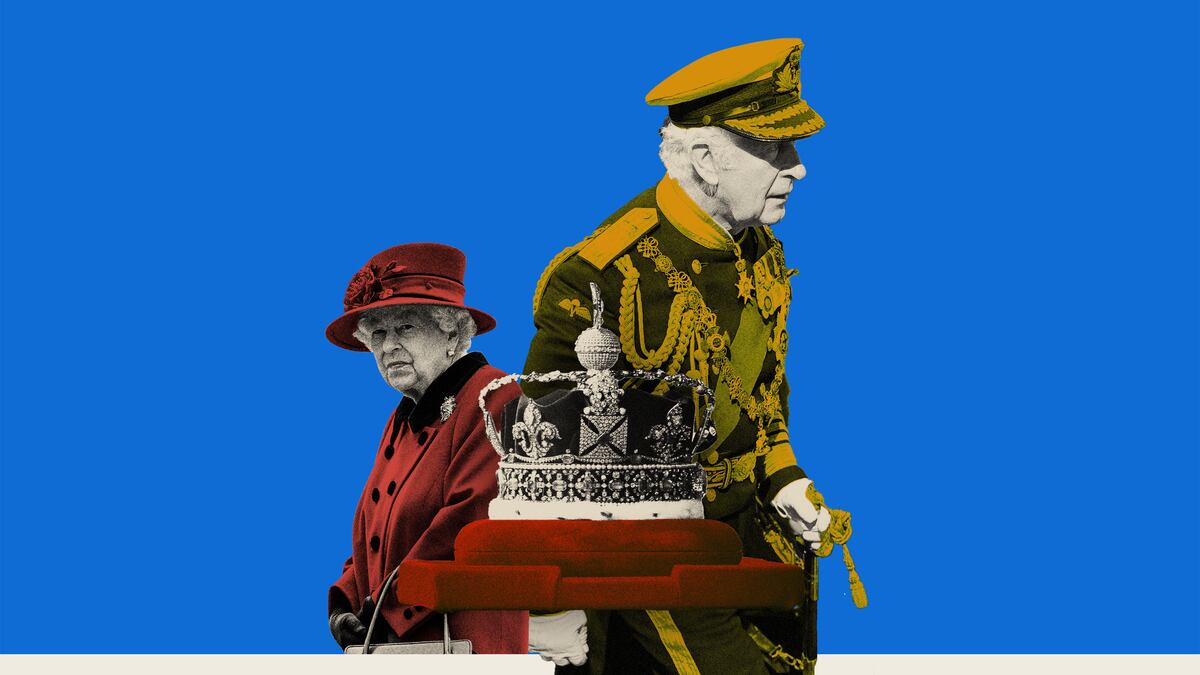As Prince Charles stared at the Imperial Crown on Tuesday morning, which was seated on a velvet cushion rather than his mother’s head, he looked morose and a little lost.
Charles is certainly passionate about fulfilling his destiny and ascending to the throne. And his appearance in the Houses of Parliament Tuesday, tasked with carrying out the most important constitutional duty of the British monarch in his mother’s place, opening the new legislative session of Parliament, was an invitation to him—and the world—to cast their minds forward to how his reign will look and feel.
But between now and then, there is the unavoidable fact of the death of his mother. And the consequent unavoidable question, following her last minute decision not to appear in London Tuesday for that ceremony, is how soon that will be.
Her age and her apparent inability to carry out any of her key duties any more—she won’t be appearing a this summer’s garden parties, for example—were already stoking speculation that Buckingham Palace are playing down the true extent of the challenges to her health by describing her as merely suffering “episodic mobility problems.”
But Prince Charles’ appearance in full military regalia and seated on a throne (actually, he sat on the consort’s throne, which is a symbolic inch shorter than the monarch’s) at the Palace of Westminster, and the fact that the queen deputized her son and heir to act for her using the Regency Act, officially sent the rumor mill into overdrive.

Britain's Prince Charles, Prince of Wales (2nd R) reads the Queen's Speech as he sits by the Imperial State Crown (2nd L), Britain's Camilla, Duchess of Cornwall (R) and Britain's Prince William, Duke of Cambridge (L) in the House of Lords chamber, during the State Opening of Parliament, at the Houses of Parliament, in London, on May 10, 2022.
ARTHUR EDWARDS/POOL/AFP via Getty ImagesEven Buckingham Palace is now conceding in briefings that the queen might not manage to make a live appearance at the Platinum Jubilee and that her presence (or otherwise) will just be a matter of how she feels on the day.
At best, it is thought, the queen might make one balcony appearance for Trooping the Color (her official birthday, which falls on Thursday June 2 this year, the opening of the Jubilee weekend) and perhaps one more “surprise” appearance on the closing Sunday evening of the Jubilee weekend.
She is scheduled to attend St Paul’s Cathedral’s service of Thanksgiving for her reign, which Harry and Meghan will likely attend. But the idea of her sitting through a lengthy church service in her own honor feels like a fantasy after Tuesday’s no-show.
At the palace, there is an increasing sense of readiness for the moment when London Bridge finally falls (“London Bridge is down” is the code phrase that will be used by government and palace officials to signify that the queen has died when the dread day comes).
The speculation and gossip may be hitting overdrive, but the truth is that nobody knows exactly what is wrong with the queen, outside, one assumes, of her doctor (and perhaps Prince Charles, which might explain his hangdog expression).
The most convincing rumors are the ones that suggest she has problems with her heart, and say that the reason she had to go into hospital for tests last year was because she had to have an MRI. These whole body scans are one of the few procedures that cannot be done in a home hospital of the type that has been established in Buckingham Palace for many years, and now rumored to exist in Windsor Castle, where the queen now lives.
But of course an MRI can be used to diagnose a whole range of health problems, including back issues, which would fit neatly with the palace’s narrative that there is nothing more worrying ailing the queen than a little bother getting around from time to time.
The extreme secrecy around HM’s wellbeing echoes the curtain pulled over the declining health of her father, George VI, who died in 1952 of complications due to lung cancer. He was 56. He failed to recover after a surgical procedure to remove a cancerous lung in 1951, and his death came as a complete shock to the nation and his family, although probably not to his doctors.
The case of a 96-year-old person is of course, very different. Everyone dies in the end, after all; they just don’t usually do it in the glare of the media spotlight.
There are still a number of informed observers, however, who think that the queen could carry on for longer than some people think.
And it should be noted that there is really no doubt among people who know her or have spent time with her that, happily, the queen’s mental faculties are quite unaffected, whatever physical ailments are besetting her. Her prime ministerial audience Wednesday is expected to go ahead as planned, for example, and she will even do a few video-link engagements this week.
Robert Hardman, author of Queen of Our Times, a definitive biography of Elizabeth produced with the help of Buckingham Palace, told The Daily Beast: “I think the issue genuinely is mobility, not something more medically troubling. But the point is that her absence at the State Opening of Parliament is not unprecedented, but the resolution to her absence—the use of the Regency Act—is. But this hasn’t been done on behalf of the sovereign, like the last time we had a regency, in 1811. This was the Sovereign laying down the rules.
“It’s another slow and gradual move in a transition that has seen Charles taking on more and more, which actually began nine years ago when he traveled to Sri Lanka to open the Commonwealth Heads of Government Meeting there.”
The Regency Act, officially signed into law in 1937, specified a permanent fall back position in case the monarch was unable to carry out their duties. In fact the immediate impetus was because Princess Elizabeth, heir apparent, was then under the age of 18. (Prior to 1937 a regency could only be established on case by case basis; for example, the Regency Act of 1811 allowed the Prince of Wales to stand in for George III.) The 1937 Act specified that a regent should be appointed if “the Sovereign is by reason of infirmity of mind or body incapable for the time being of performing the royal functions,” and it also applied to monarchs who were minors.
Clive Irving, the founding editor of The Sunday Times’ Insight investigative journalism team, and author of The Last Queen, told The Daily Beast: “It’s critical to grasp a point that gets easily overlooked because there is so little precedent to guide it: She does not have to die in the saddle, like Victoria, after a rapid decline. There is nothing in the protocols to say that. So the sane thing would be to have her abdicate. The use of the Regency Act is the first step towards abdication, which, I suspect, will happen once the Jubilee is over.”
The Daily Beast has previously revealed the the queen is using a wheelchair at home, something the palace has not been willing to confirm, and there is a sense that the queen does not want to become a “wheelchair monarch.” Some might say that only increases the pressure on her to step down.
Duncan Larcombe, former royal editor at The Sun, told The Daily Beast: “My understanding is that there is nothing catastrophically wrong, she just is 96, and I suspect, for all the palace’s denials, that Charles will actually be officially installed in some kind of regency capacity within a year.
“Tuesday changed everything. The queen really has no option if she is continually unable to perform her role as head of state. It’s one thing not being able to go to an engagement in Glasgow for a climate summit, but if she is now apparently incapable of doing standard, core jobs as head of state, then I think they will have to remove her, by consent of course.”
Larcombe said the palace was using the word “mobility” to avoid using the word “infirmity” which, you might trigger the Regency Act. “But in the end, if the CEO can’t ever go into the office, they can’t do any of the actual in-person work, he told The Daily Beast. “In her case that’s the investitures, the trooping of the color, the garden parties and opening Parliament. There is no coming back from today and they all know it.
“The use of the Regency Act was very deliberate. I am sure at Buckingham Palace and Clarence House they are all very happy with how it went today. He didn’t fluff his lines, he was well received. It is all going to make the Jubilee hugely poignant, as I think by then it will have dawned on us all that this will be the last time we will ever see her. The countdown has begun.”
The palace said it had “nothing to add” to Monday’s statement, which said: “The queen continues to experience episodic mobility problems, and in consultation with her doctors has reluctantly decided that she will not attend the State Opening of Parliament tomorrow. At Her Majesty’s request, and with the agreement of the relevant authorities, The Prince of Wales will read the queen’s speech on Her Majesty’s behalf, with The Duke of Cambridge also in attendance.”
A source at the palace said, however, that the queen had “a busy diary this week with a call with Australia…a planned Privy Council and PM audience (virtual and by phone) on Wednesday and is expected to undertake some private engagements later in the week.”







